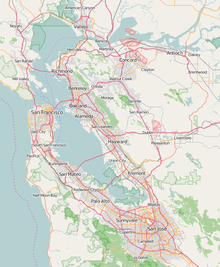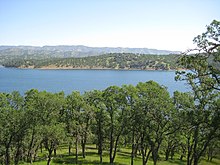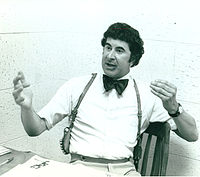Zodiac Killer
![]()
This article is about the serial killer. For the feature film, see The Zodiac Killer.
![]()
This article is still missing the following important information:
* other cases of suspected perpetration
- last letter from 1974 and following letters of uncertain authorship
- other suspects
Help Wikipedia by researching and adding them.
Zodiac Killer is the pseudonym of a serial killer in the United States who murdered five people in the San Francisco Bay Area between December 1968 and October 1969. Two others survived his attacks seriously injured. His identity could not be determined until today.
Over several years, the perpetrator sent bizarre letters to local newspapers, some of them encoded with symbols and medieval characters. Of the four coded texts, two have so far been deciphered. The meaning of the other two is as yet unclear. In one of them, the perpetrator announces his real name. The name Zodiac he gave himself, alluding to the Zodiac symbol.
His victims were mostly young couples, whom he ambushed in lonely places. In his letters, he boasted of his deeds and announced more to come. While the investigating authorities officially speak of seven victims, the Zodiac Killer claimed in one of his letters to have committed 37 murders.

The zodiac symbol used by the Zodiac killer

Photofit of the alleged perpetrator
Number of victims and crime pattern
The Zodiac killer claimed in one of his letters to the press to have killed 37 people. However, investigators confirmed only seven victims, two of whom survived. The confirmed attacks had the following commonalities:
- The murders were committed on the weekend or on a holiday.
- All but one of the victims were high school or college students traveling in pairs.
- The crimes occurred at dusk or at night.
- The murders were committed in cars or near a car.
- The perpetrator used a different weapon each time.
- The crime scenes were usually secluded places that were often visited by lovers.
- The motive for the crime did not appear to be greed, nor were the victims sexually assaulted.
- The perpetrator bragged about the murders by phone and in letters.
- The crime scenes were in the San Francisco Bay Area.
- The murders were committed near bodies of water or in places whose name referred to a body of water.

The Zodiac Killer's killing spree occurred in the San Francisco Bay Area in the US state of California
Chronology of the murder series
Police confirmed perpetration
Double murder on 20 December 1968 near Benicia
At about 7:30 p.m. on Friday, December 20, 1968, 17-year-old David Arthur Faraday, who attended Vallejo High School, drove his mother's Rambler station wagon to the home of 16-year-old Betty Lou Jensen, with whom he had arranged a first date. Jensen, a student at Hogan High School in Vallejo, had told her parents they were attending a Christmas concert at her school. Faraday and Jensen left at 8:20 p.m., but instead of attending the concert, they first drove to a classmate of Jensen's, with whom they stayed until 9 p.m., and then to a drive-in restaurant. They then left Vallejo and followed Lake Herman Road east. Shortly after 10 p.m., they parked about five yards from the side of the road at the Benicia Water Works - a place often frequented by lovers because of its seclusion (38° 5′ 41.6″ N, 122° 8′ 38.2″ W38.094891666667-122.143955556). Around 11 p.m., Faraday and Jensen were last seen alive there by witnesses. Two men hunting raccoon nearby observed a car leave Lake Herman Road and park next to the Rambler a few minutes later; they could not recognize the person behind the wheel.
The following events could not be reconstructed with certainty due to the lack of witnesses. Robert Graysmith in his factual novel Zodiac - On the Trail of a Serial Killer assumes the following scenario: The driver of the second car got out, shot the right rear window with a pistol, and then fired at the left rear wheel well. The young couple then attempted to flee through the passenger side front door. Faraday was seriously injured by a gunshot to the head as he exited the car and fell to the gravel floor in front of the passenger door. Jensen ran away in a northerly direction, but after about nine yards was struck in the back by five bullets and also fell to the ground. The offender then drove off in his car. When a local resident drove by the scene around 11:15 p.m. and saw the two victims lying next to the Rambler, she continued toward Benicia to get help. On the way, she stopped an oncoming police patrol and told the two officers of her discovery. By the time officers arrived on the scene around 11:30 p.m., Jensen had succumbed to her injuries. Faraday died shortly after midnight on the way to the hospital. .22 caliber shell casings were recovered at the scene.
Murder on July 4, 1969 in Vallejo
On Friday, July 4, 1969, Darlene Ferrin, a 22-year-old waitress, and her 19-year-old companion, Mike Mageau, who were riding in Ferrin's car in Vallejo late that evening, were followed by a man in a light-colored car. According to Mageau's later testimony, the pursuer's car was probably a tan Chevrolet or Ford Falcon, 1958 or 1959 model, with old California license plates. As Ferrin turned into the parking lot of the Blue Rock Springs Golf Course (38° 7′ 33.6″ N, 122° 11′ 27.9″ W38.1259888889-122.191094444), her car's engine failed. The other car came to a stop in the darkness to the left of Ferrin and Mageau with its headlights off. Mageau asked Ferrin if she knew the man, to which the 22-year-old said, "Oh, don't worry about it. It's going to be okay." Shortly after, the unidentified man sped away in his car, but returned five minutes later, this time parking behind Ferrin's car, cutting off her and Mageau's path. He left his car's headlights on, got out of his car, and walked toward Ferrin and Mageau, alternately shining a hand lamp at them. Mageau believed it must be a police officer and asked Ferrin to produce her identification.
The unidentified man shined his flashlight through the rolled-down passenger window and then fired several shots at Ferrin and Mageau. Ferrin was struck by eleven bullets and Mageau suffered serious injuries from multiple gunshots. The unknown perpetrator then drove away. Approximately fifteen minutes later, Ferrin and Mageau, who were both alive at the time, were found by three teenagers who notified police at 00:12. The victims were taken to the hospital, where Ferrin succumbed to her injuries at 00:38. Mageau survived the attack.
At 00:40 a.m., a call was received at Vallejo Police Headquarters. The caller had a male voice and said in a calm, determined tone, "I'd like to report a double homicide. If you drive on Columbus Parkway a mile east toward the park, you will find two young people in a brown car in the parking lot. They were shot with a 9-millimeter Luger. I also killed those two young people last year. Goodbye." The call could be traced to a pay phone located just outside the Vallejo Sheriff's Office and within sight of Darlene Ferrin's home. At 01:30, the phone rang at the home of Ferrin and her husband. A friend who was visiting the Ferrins picked up the receiver and heard heavy, deep breathing on the other end of the line, but the caller said nothing. A few minutes later, Darlene Ferrin's in-laws and brother-in-law received similar calls. When the anonymous calls reached Ferrin's relatives, the attack had not yet been reported in the media.
Murder at Lake Berryessa on September 27, 1969.
On Saturday, September 27, 1969, 22-year-old college student Cecelia Ann Shepard and her 20-year-old boyfriend Bryan Hartnell, a law student, were spending the afternoon on a secluded, deserted stretch of beach on the western shore of Lake Berryessa (38° 33′ 48.3″ N, 122° 13′ 54.4″ W38.563413888889-122.23178611111). They had parked Hartnell's VW Karmann Ghia about 500 yards away on the side of the road. After some time, Shepard noticed a darkly dressed man in the distance who appeared to be watching them and slowly approached. When the man was only a few feet away from them, Shepard spotted a semi-automatic pistol in his hand. The unknown man said, "I want your money and the car keys. I need the car because I'm going to Mexico." The man also claimed that he had escaped from the prison in Deer Lodge, Montana, and was driving a stolen car. He had killed a guard and had nothing left to lose, he said.
After Hartnell handed him what little change he had on him and the car keys, the man ordered the two students to lie face down on the picnic blanket they had brought with them. He required Shepard to tie Hartnell's hands behind her back with a piece of plastic clothesline, after which the unidentified man tied Shepard in the same manner and pulled Hartnell's restraints even tighter. Hartnell offered the man legal assistance, to which the man did not respond. When Hartnell asked him if the gun was even loaded, the unknown man pulled out the magazine and showed him the round inside. The man then began stabbing first Hartnell and then Shepard with a long knife. He then left the scene, leaving the money and car keys behind. Before driving away, he wrote on the door of Hartnell's car the date of the first two attacks at Vallejo and the date, time, and manner of committing the crime in the Lake Berryessa attack. Above this he drew the symbol ![]() .
.
The two seriously injured managed to free each other from their bonds. A fisherman who had seen the two injured students from the lake notified the Rangers. Both victims were taken to the hospital, where Shepard succumbed to her 24 stab wounds on September 29, 1969. Hartnell survived six stab wounds.
About an hour after the attack on Shepard and Hartnell, a male caller had phoned the Napa Police Department and said in a calm voice, "I'd like to report a murder-no, a double murder. They're two miles north of Park Headquarters. They were driving a white VW Karmann Ghia. I'm the one who did it." The caller then put the phone down without disconnecting. The officer who answered the call estimated the man's age to be in his early 20s based on the sound of his voice, and the call was traced to a phone booth on Main Street in Napa, four and a half blocks from the police department and 43 kilometers from the crime scene. In the phone booth, investigators recovered a trace of a palm print on the receiver.
Murder in Presidio Heights, October 11, 1969.
On Saturday, October 11, 1969, taxi driver Paul Lee Stine had a passenger get into his cab in front of the Pinecrest Diner on Geary Street in San Francisco, who told him the destination was "Washington Street and Maple" in Presidio Heights. Approximately fifteen minutes later they arrived at their destination. The passenger told Stine to drive one more block. When the cab came to a stop in front of the house at 3898 Washington Street, the unidentified man put a gun to Stine's right cheek from behind and pulled the trigger.
When guests at a party at the house across the street looked down at the taxi from a first-floor window around 9:55 p.m., they thought they saw a fight or robbery and called police. For unexplained reasons, when the description of the perpetrator was recorded, it was incorrectly noted that the suspect was of African-American descent. Meanwhile, the offender, who was in fact a white male, left the scene in the direction of Presidio. He was stopped at the corner of Jackson and Cherry Streets at 10 p.m. by a police patrol unit en route to the scene. Since the person stopped did not fit the profile of the wanted man, the unsuspecting officers let the offender go.
When the summoned ambulance arrived at the scene at 10:10 p.m., Stine was already dead. The perpetrator had taken his wallet, but left behind his watch, ring and checkbook. A 9-millimeter shell casing was recovered from the taxi. A manhunt for the offender ended unsuccessfully at 2am. The case was assigned to Inspector Dave Toschi of the San Francisco Police Department Homicide Division and his partner Bill Armstrong.
Suspected perpetration
Murder in Riverside on October 30, 1966.
Late on the evening of October 30, 1966, 18-year-old college student Cheri Jo Bates was killed in Riverside, Southern California, after visiting a library. Investigators believed that the perpetrator had tampered with an ignition distributor wire on her car while Bates was away and then offered to "help" her when she was unable to start the car. The next morning, Bates' body was found in a parking lot about 70 yards from her car with her throat slit and several stab wounds as well as cuts. In April 1967, an unknown man wrote two letters to local police sharing perpetrator information, threatening to kill more victims, and demanding his lines be made public. The anonymous writer had also sent a similar letter to a local newspaper. After comparing the handwriting, handwriting expert Sherwood Morrill became convinced that it was the handwriting of the Zodiac Killer. On March 15, 1971, the Zodiac Killer wrote a letter to the Los Angeles Times confirming his perpetration of the Bates murder case. Nevertheless, it could not be determined with certainty whether Bates had actually been a victim of the serial killer. The investigators also considered it possible that the Zodiac killer only knew about the unsolved murder from the newspaper and declared it as his own crime in order to draw attention to himself again.
Kidnapping on March 22, 1970, near Modesto...
On the night of March 22, 1970, Kathleen Johns, seven months pregnant, was driving west on dimly traveled State Route 132 with her ten-month-old daughter when she noticed in her rearview mirror a car that appeared to have been following her since Modesto. Shortly after midnight, the driver of the car behind began honking his horn and flashing his headlights on and off. When Johns did not respond to the signals, the driver of the car swerved into the oncoming lane, pulled alongside Johns' car, and shouted to her through his passenger window that her left rear wheel was loose. Johns then pulled over to the side of the road, where the unidentified man offered to tighten her lug nuts. After tampering with the wheel for some time, the man told Johns that she could continue driving without worry and drove away. Johns continued her ride, but after only a few feet, the left rear wheel came loose. When she stopped, the stranger returned and explained that the problem was probably bigger than she thought. He offered her a ride to a gas station in sight, whereupon Johns got in the car with her daughter.
Instead of stopping at the gas station, however, the man drove past it. When Johns approached him about it, the stranger informed her that he would kill her and her baby. During the two to three hour drive that followed, the man repeated the threat several times. When the car came to a brief stop due to traffic, Johns jumped out of the car with her daughter in her arms and ran into a field where she hid in tall grass until the stranger gave up his search for her and drove away. The driver of a passing semi-truck took Johns to the Patterson police station, where she gave her statement for the record. When she caught sight of a composite sketch of the Zodiac killer hanging on the wall, she thought she recognized her abductor in the drawing. Johns' car was later found where she had left it - someone had stripped it and set it on fire.

Lake Berryessa, scene of the third known attack by the Zodiac Killer...

State Route 132 (red) where Kathleen Johns and her daughter were abducted west of Modesto.

The door of Bryan Hartnell's car, inscribed by the Zodiac Killer, 1969.

Inspector Dave Toschi, 1976
Questions and Answers
Q: Who was the Zodiac Killer?
A: The Zodiac Killer or Zodiac was a serial killer who operated in Northern California from at least the late 1960s to the early 1970s.
Q: When did the murders take place?
A: The murders took place between December 1968 and October 1969.
Q: How many victims were targeted by the killer?
A: Four men and three women between the ages of 16 and 29 were targeted.
Q: What name did the killer use for himself?
A: The killer originated the name "Zodiac" in a series of taunting letters sent to the local Bay Area press.
Q: How many cryptograms were sent by the killer?
A: Four cryptograms (or ciphers) were sent by the killer.
Q: How many of these cryptograms have been solved?
A: Only one of these cryptograms has been definitively solved.
Search within the encyclopedia